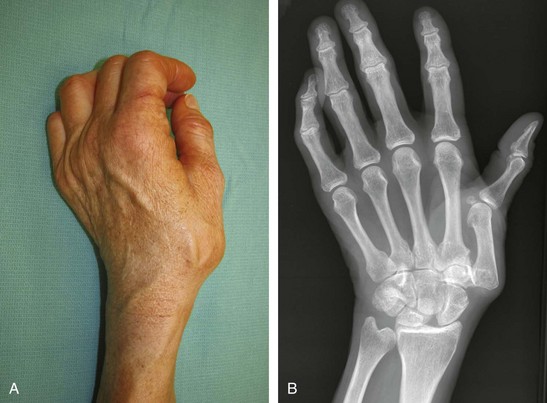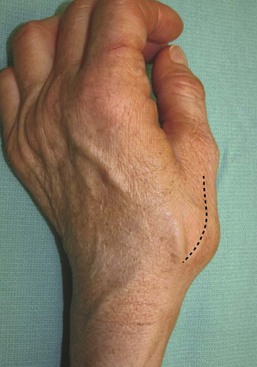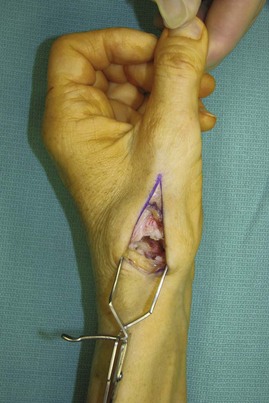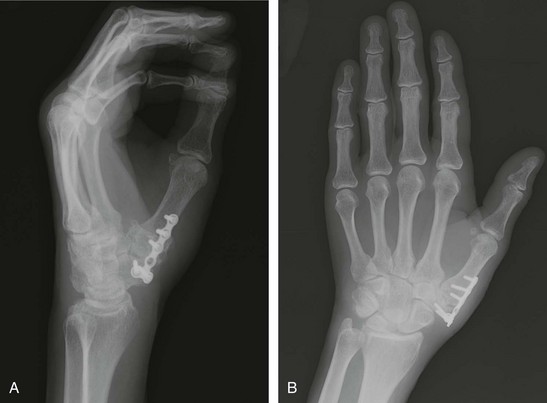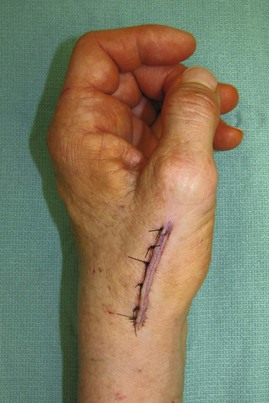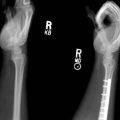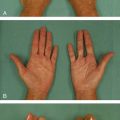Procedure 63 Trapeziometacarpal Fusion
![]() See Video 47: Fusion of Thumb Carpometacarpal Joint
See Video 47: Fusion of Thumb Carpometacarpal Joint
Indications
 Posttraumatic degenerative osteoarthritis of the trapeziometacarpal (TMC) joint in manual workers who require great stability of the carpometacarpal (CMC) joint, which may not be achieved with trapezium excision and ligament reconstruction
Posttraumatic degenerative osteoarthritis of the trapeziometacarpal (TMC) joint in manual workers who require great stability of the carpometacarpal (CMC) joint, which may not be achieved with trapezium excision and ligament reconstruction
 Patients with substantial joint laxity and severe thumb CMC joint deformity that cannot be treated with soft tissue reconstruction alone
Patients with substantial joint laxity and severe thumb CMC joint deformity that cannot be treated with soft tissue reconstruction alone
Examination/Imaging
Clinical Examination
 The patient’s thumb should be evaluated for tenderness along the TMC joint.
The patient’s thumb should be evaluated for tenderness along the TMC joint.
 The grind test is performed with axial compression, flexion, extension, and circumduction of the TMC joint, which should elicit crepitus and pain.
The grind test is performed with axial compression, flexion, extension, and circumduction of the TMC joint, which should elicit crepitus and pain.
 The patient’s thumb metacarpophalangeal (MCP) joint should be assessed during pinch for hyperextensibility that can be corrected with MCP joint capsulodesis.
The patient’s thumb metacarpophalangeal (MCP) joint should be assessed during pinch for hyperextensibility that can be corrected with MCP joint capsulodesis.
 The Allen test should be performed because the procedure typically requires mobilization of and potential injury to the radial artery.
The Allen test should be performed because the procedure typically requires mobilization of and potential injury to the radial artery.
Surgical Anatomy
 The TMC joint is a biconcave saddle-shaped joint that provides motion in several planes to allow thumb flexion, extension, abduction, adduction, and opposition.
The TMC joint is a biconcave saddle-shaped joint that provides motion in several planes to allow thumb flexion, extension, abduction, adduction, and opposition.
 The volar oblique (beak) ligament inserts volarly onto the trapezium from its confluence with articular cartilage on the beak of the thumb metacarpal and is considered the primary stabilizer of the TMC joint. It serves as the main restraint against dorsal translation of the metacarpal on the trapezium, and laxity of the beak ligament increases the risk for degenerative changes seen in the CMC joint due to loss of joint stabilization.
The volar oblique (beak) ligament inserts volarly onto the trapezium from its confluence with articular cartilage on the beak of the thumb metacarpal and is considered the primary stabilizer of the TMC joint. It serves as the main restraint against dorsal translation of the metacarpal on the trapezium, and laxity of the beak ligament increases the risk for degenerative changes seen in the CMC joint due to loss of joint stabilization.
 The radial artery traverses the anatomic snuffbox and overlies the dorsal capsule of the CMC joint.
The radial artery traverses the anatomic snuffbox and overlies the dorsal capsule of the CMC joint.
 The abductor pollicis longus (APL) and extensor pollicis brevis (EPB) tendons are within the first extensor compartment.
The abductor pollicis longus (APL) and extensor pollicis brevis (EPB) tendons are within the first extensor compartment.
 The radial sensory nerve becomes subcutaneous after exiting through the interval between the brachioradialis and extensor carpi radialis longus (ECRL) muscles.
The radial sensory nerve becomes subcutaneous after exiting through the interval between the brachioradialis and extensor carpi radialis longus (ECRL) muscles.
Exposures
 A 4-cm dorsal longitudinal incision overlying the TMC joint is made in the interval between the extensor pollicis longus (EPL) and EPB tendons to the level of the dorsal joint capsule (Fig. 63-2). The EPL tendon and radial artery should be retracted to expose the joint capsule.
A 4-cm dorsal longitudinal incision overlying the TMC joint is made in the interval between the extensor pollicis longus (EPL) and EPB tendons to the level of the dorsal joint capsule (Fig. 63-2). The EPL tendon and radial artery should be retracted to expose the joint capsule.
Procedure
Step 1
Step 2
Step 3
 A 2.3-mm locking T-plate is applied for arthrodesis. The locking plate is particularly helpful for fusion of this joint because the trapezium may be devoid of strong cortical bone for secure screw purchase in the traditional plating system, which relies on the friction between the screw and the bone for stability. The locking plate system locks the screw to the plate, which adds additional stability to the fusion site. After confirming that the plate is in the center of the metacarpal and that the T portion is centered on the trapezium, a locking screw is placed to secure the plate to the metacarpal. The remaining screws are placed in a locking fashion to provide stable fixation.
A 2.3-mm locking T-plate is applied for arthrodesis. The locking plate is particularly helpful for fusion of this joint because the trapezium may be devoid of strong cortical bone for secure screw purchase in the traditional plating system, which relies on the friction between the screw and the bone for stability. The locking plate system locks the screw to the plate, which adds additional stability to the fusion site. After confirming that the plate is in the center of the metacarpal and that the T portion is centered on the trapezium, a locking screw is placed to secure the plate to the metacarpal. The remaining screws are placed in a locking fashion to provide stable fixation.
Step 4
Step 5
 The periosteal flaps and joint capsule are closed in layers over the implant using 4-0 absorbable braided suture. The tourniquet is released, and all bleeding points are cauterized. Skin is closed using 4-0 permanent monofilament horizontal mattress sutures, and the hand is placed in a thumb spica splint (Fig. 63-5).
The periosteal flaps and joint capsule are closed in layers over the implant using 4-0 absorbable braided suture. The tourniquet is released, and all bleeding points are cauterized. Skin is closed using 4-0 permanent monofilament horizontal mattress sutures, and the hand is placed in a thumb spica splint (Fig. 63-5).
Postoperative Care and Expected Outcomes
 Because of the potential for nonunion, the patient’s thumb remains immobilized in a thumb spica splint for 6 weeks to allow bony fusion. After 6 weeks, the patient begins gentle active range-of-motion exercises.
Because of the potential for nonunion, the patient’s thumb remains immobilized in a thumb spica splint for 6 weeks to allow bony fusion. After 6 weeks, the patient begins gentle active range-of-motion exercises.
 Expected outcomes include improved pain relief and improved hand function with insignificant change in strength despite loss of motion. Patients should be expected to return to their normal activities.
Expected outcomes include improved pain relief and improved hand function with insignificant change in strength despite loss of motion. Patients should be expected to return to their normal activities.
Hartigan BJ, Stern PJ, Kiefhaber TR. Thumb carpometacarpal osteoarthritis: arthrodesis compared with ligament reconstruction and tendon interposition. J Bone Joint Surg [Am]. 2001;83:1470-1478.
Kenniston JA, Bozentka DJ. Treatment of advanced carpometacarpal joint disease: arthrodesis. Hand Clin.. 2008;24:285-294.
Taylor EJ, Deari K, D’Arcy JC, Bonnici AV. A comparison of fusion, trapeziectomy and Silastic replacement for the treatment of osteoarthritis of the trapeziometacarpal joint. J Hand Surg [Br]. 2005;30:45-49.


